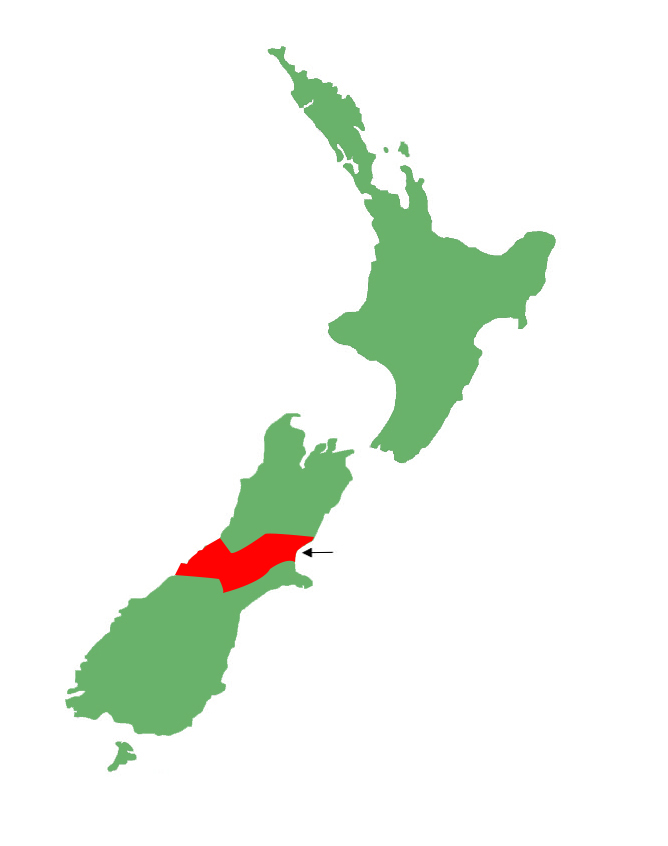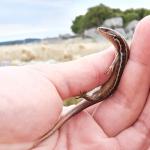- Home
- Herpetofauna Index
- Native
- Oligosoma Aff. Polychroma Clade 4
Oligosoma aff. polychroma Clade 4
Canterbury grass skink
Oligosoma aff. polychroma Clade 4
Length: SVL up to 85mm, with the tail being equal to or slightly longer than the body length
Weight: unknown
Description
Formerly regarded as the 'common skink' (which has now been split into five separate species), Canterbury grass skinks are locally abundant within their range and may be encountered in both native or modified (agricultural) habitats.
Canterbury grass skinks are similar in appearance to other members of the grass skink complex, and variable in colour / pattern. Head has a short, blunt snout. The dorsal surfaces are often various shades of brown with cream or pale-brown dorsolateral stripes which may be smooth-edged or serrated, a mid dorsal stripe (when present) usually extends down the tail. Flanks have a broad dark brown lateral stripe, often edged with black and bordered below by a cream-coloured stripe which may be smooth or crenulated. A pale stripe runs down the anterior surface of the forelimb. The ventral surface is variously coloured shades of grey, brown, or yellow, without speckling.
May be confused with McCann's skinks (Oligosoma maccanni). But in the northern part of their range can be distingushed from McCann's skinks by the notched / jagged dorsolateral and lateral stripes (versus smooth edged in northern McCann's skinks). Where Canterbury grass skinks have smooth stripes they can be distinguished by having a more brown (versus grey) colouration, absence of flecking on the dorsum, and the mid-dorsal stripe continuing down the intact tail (versus breaking up in the tail in McCann's skinks).
Life expectancy
Unknown.
Distribution
Occurs in the South Island from the north Canterbury coast, through inland Canterbury and the main divide, across to the southern West Coast south of Hokitika. May also occur in the Mackenzie basin and Lindis Pass area.
Ecology and habitat
Canterbury grass skinks are diurnal, bold and strongly heliothermic. They can often be seen out basking fully exposed in sunny areas.
In common with other grass skinks the species occupies a wide range of habitat types from coastal to alpine zones, preferring open areas including coastal vegetation, rock piles, grassland, tussock, shrubland, screes, forest margins tussock and modified agricultural habitats where there is sufficient cover. Often takes refuge in dense vegetation, in screes, or under rocks and logs when not active.
Social structure
Thought to be largely solitary, but may live in high-density colonies where multiple individuals can be observed basking in close proximity.
Breeding biology
Canterbury grass skinks reach maturity in around 1.5 - 2 years, mature females reproduce annually giving birth to litters of up to six juveniles in mid-to-late summer (January- February) after a gestation of three months.
Diet
Canterbury grass skinks are active hunters and consume a wide range of small invertebrates such as spiders, insects, isopods and molluscs. They also consume the berries / fruit from native plants.
Disease
Canterbury grass skinks are known hosts for endoparasitic nematodes in the Skrjabinodon genus.
Conservation strategy
Canterbury grass skinks are regarded as "At Risk - Declining."
No specific conservation strategy has been developed for Canterbury grass skinks.
Interesting notes
Canterbury grass skinks are part of a cryptic species complex which includes the northern grass skink (Oligosoma polychroma), Waiharakeke grass skink (Oligosoma aff. polychroma Clade 2), south Marlborough grass skink (Oligosoma aff. polychroma Clade 3), and southern grass skink (Oligosoma aff. polychroma Clade 5). The various species are regionally distributed, similar in both appearance and habit, and were once regarded as a single highly variable species - the 'common skink'. There are currently no known morphological features to distinguish Canterbury grass skinks from the other species within the complex.
References
Hitchmough, R.A., Barr, B., Lettink, M., Monks, J., Reardon, J., Tocher, M., van Winkel, D., Rolfe, J. (2016). Conservation status of New Zealand reptiles, 2015; New Zealand threat classification series 17. Wellington: New Zealand Department of Conservation.
Jewell, T. (2011). A photographic guide to reptiles and amphibians of New Zealand. Auckland: New Holland Publishing.
Robb, J. (1986). New Zealand Amphibians & Reptiles (Revised). Auckland: Collins, 128 pp.
van Winkel, D., Baling, M. & Hitchmough, R. (2018). Reptiles and Amphibians of New Zealand: A field guide. Auckland: Auckland University Press, 376 pp.


